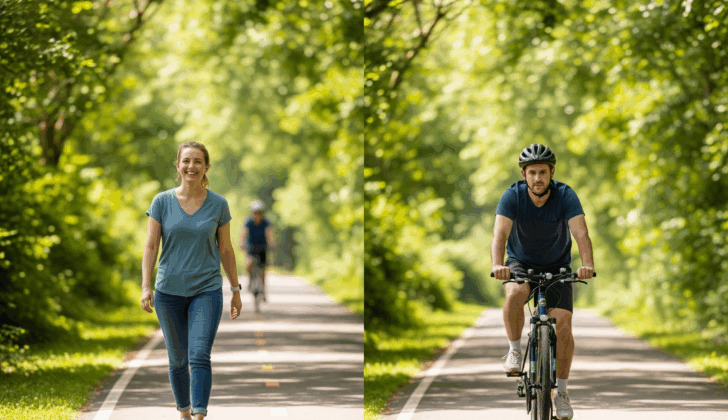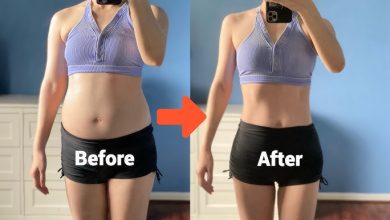Walking vs. Cycling: Which Burns More Fat Faster?

When it comes to fitness and weight loss, many people wonder which activity is better: walking vs. cycling. Both are excellent forms of cardiovascular exercise that can help you burn calories, improve your health, and enhance your overall fitness level. But if your primary goal is to shed fat as quickly as possible, you’ll want to know the differences between these two activities.
In this comprehensive guide, we’ll compare walking vs. cycling in terms of calorie burn, fat loss potential, health benefits, convenience, and more. By the end, you’ll have a clear understanding of which one suits your active lifestyle and goals better.
Why Compare Walking vs. Cycling?
Both walking and cycling are among the most popular forms of exercise worldwide. They require minimal equipment, can be performed outdoors or indoors, and are accessible to most people regardless of age or fitness level.
However, the choice between walking vs. cycling depends on various factors:
- How many calories you want to burn
- The amount of time you can commit
- Your fitness level and joint health
- Accessibility of equipment (bike vs. shoes)
- Your personal enjoyment
Because fat loss is primarily determined by creating a calorie deficit, the activity that burns many calories may help you lose fat faster—provided you maintain a healthy diet.
Calorie Burn: Walking vs. Cycling
The first thing most people want to know is which activity burns more calories.
Walking
- The average person burns 240–360 calories per hour walking at a brisk pace (around 3.5–4 mph).
- Walking uphill or adding intervals increases calorie burn significantly.
- Walking is a weight-bearing activity, which means you also engage your bones and muscles more directly than in cycling.
Cycling
- A moderate cycling session (12–14 mph) burns 450–600 calories per hour.
- Vigorous cycling (16–20 mph) can torch 700–900 calories per hour.
- Even at lower intensities, cycling tends to burn more calories than walking because you move faster and engage large muscle groups (quads, hamstrings, glutes).
Winner for calorie burn: Cycling.
If fat loss is your primary goal and you’re pressed for time, cycling usually provides a faster calorie deficit compared to walking.
Fat Burning Zones: The Science Behind It
Some fitness enthusiasts argue that walking burns more fat than cycling because it keeps you in the so-called “fat-burning zone” (about 60–70% of maximum heart rate). However, the reality is more complex.
- Walking often keeps you at a lower intensity, which means a higher percentage of your calories come from fat. But the total calorie burn is lower.
- Cycling at moderate to vigorous intensity burns more many calories, so even if the percentage of fat calories is lower, the absolute amount of fat burned is higher.
For example:
- Walking might burn 300 calories with 60% from fat = 180 fat calories.
- Cycling might burn 600 calories with 40% from fat = 240 fat calories.
That’s why, in practice, cycling usually burns more fat overall.
Walking vs. Cycling for Weight Loss
Fat loss is not just about what percentage of calories come from fat—it’s about total energy expenditure.
- Walking is easier to sustain for long periods. Many people can walk for 90 minutes daily without much strain, which adds up in calorie burn.
- Cycling allows for more intensity in less time. Even a 30–45-minute ride can match or exceed the calorie burn of a much longer walk.
If you’re consistent with either, both can help you lose weight. The real question is: Which one can you stick with for weeks and months?
Impact on Joints and Muscles
Another key factor in the walking vs. cycling debate is joint health.
Walking
- Low-impact compared to running but still weight-bearing.
- Helps strengthen bones and improve bone density.
- May cause discomfort for people with knee, hip, or ankle arthritis if overdone.
Cycling
- Non-weight-bearing and much gentler on joints.
- Excellent for people recovering from injuries or with arthritis.
- Builds stronger leg muscles (quads, hamstrings, calves, glutes) compared to walking.
Winner for joint-friendliness: Cycling.
Convenience: Walking vs. Cycling
For fat loss, convenience often determines long-term consistency.
- Walking: Requires only comfortable shoes. Can be done anywhere—your neighborhood, treadmill, or even during lunch breaks.
- Cycling: Requires a bicycle (or stationary bike), maintenance, and safe cycling routes. Weather conditions may also limit outdoor rides.
Winner for convenience: Walking.
Psychological Benefits
Both walking and cycling also boost mental health, which indirectly supports fat loss by reducing stress-related eating and improving mood.
- Walking: Especially powerful for mental clarity and stress relief. Walking outdoors in nature has proven effects on lowering cortisol levels.
- Cycling: Often gives a sense of thrill and freedom, especially outdoors. It can also be more social if done in groups.
Which Burns More Fat Faster? The Verdict
If we compare strictly in terms of calorie burn and fat loss speed:
- Cycling burns more fat faster due to higher energy expenditure in less time.
- Walking is more sustainable for many people, making it easier to maintain long-term weight loss.
So, if you want the quickest fat-burning workout and enjoy cycling, hop on the bike. But if you want a no-fuss, accessible, and sustainable activity, walking may be the smarter choice.
Tips to Maximize Fat Loss (Walking or Cycling)
No matter which you choose in the walking vs. cycling debate, here are ways to accelerate results:
- Add intervals – Alternate between brisk walking and power walking, or between steady cycling and sprints.
- Increase duration – Aim for 45–60 minutes per session for optimal fat burn.
- Go uphill – Walking uphill or cycling against resistance dramatically increases calorie burn.
- Stay consistent – Fat loss depends on routine. Aim for 4–6 sessions per week.
- Pair with strength training – Muscle boosts metabolism and accelerates fat loss.
- Monitor nutrition – Exercise alone won’t work without a calorie deficit.
- Track progress – Use fitness trackers to stay motivated and measure calories burned.
Walking vs. Cycling: Who Should Choose What?
Here’s a quick breakdown:
- Choose Walking If:
- You prefer simplicity and convenience.
- You have limited access to equipment.
- You enjoy long, steady activities.
- You want to strengthen your bones.
- Choose Cycling If:
- You want faster fat burn in less time.
- You enjoy high-intensity workouts.
- You have joint issues.
- You want to build stronger leg muscles.
Frequently Asked Questions (FAQs)
- Is walking or cycling better for belly fat?
Cycling generally burns more calories, which can help reduce belly fat faster. However, spot reduction isn’t possible—you’ll lose fat overall, including from the belly.
- Can I combine walking and cycling for fat loss?
Yes! Combining both keeps workouts interesting, reduces injury risk, and maximizes calorie burn.
- Which is better for beginners: walking vs. cycling?
Walking is usually easier for beginners since it requires no equipment and minimal fitness level. Cycling may require more balance and stamina.
- How much walking or cycling per day is enough for fat loss?
Aim for 45–60 minutes of moderate-intensity exercise daily, or at least 150 minutes per week as recommended by health guidelines.
- Which builds more muscle: walking vs. cycling?
Cycling builds more lower-body muscle strength, especially in the quads and glutes. Walking tones muscles but won’t build significant strength.
Final Thoughts
When it comes to walking vs. cycling, both are excellent fat-burning exercises. Cycling tends to burn more fat faster because it expends more energy in less time. Walking, however, is more convenient, sustainable, and accessible to most people.
The best choice depends on your lifestyle, preferences, and goals. The most effective exercise is the one you can do consistently. Whether you’re walking through the park or cycling down a trail, the key to fat loss is regular activity, combined with a balanced diet.
So, in the walking vs. cycling debate, the real winner is the one you’ll actually stick to.




